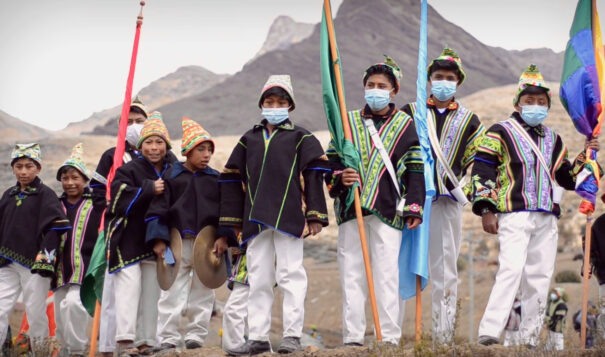News Based on facts, either observed and verified directly by the reporter, or reported and verified from knowledgeable sources.
Legacy of the Andes: Transmedia project opens window on ancient cultures’ responses in times of crisis
 Schoolchildren of the Kallawaya Nation of northern Bolivia marched in their traditional dress and performed their music with traditional instruments in the procession that begins the snow festival in Ayllu Amarete. The festival is a reinforcement and a reminder of the importance of their ancestral memory. (Image from Cosmology & Pandemic: Legacy of the Andes / The Esperanza Project)
Schoolchildren of the Kallawaya Nation of northern Bolivia marched in their traditional dress and performed their music with traditional instruments in the procession that begins the snow festival in Ayllu Amarete. The festival is a reinforcement and a reminder of the importance of their ancestral memory. (Image from Cosmology & Pandemic: Legacy of the Andes / The Esperanza Project)
Buffalo’s Fire contributing editor Tracy L. Barnett, founding editor of The Esperanza Project, is co-director of this film. Buffalo’s Fire contributing writer Talli Nauman is a longtime collaborator, advisor and contributing editor of The Esperanza Project.
The Esperanza Project, together with the support of the Pulitzer Center on Crisis Reporting and The One Foundation, has released its long-awaited transmedia project, Legacy of the Andes. This epic journey through six ancestral cultures, beginning at the height of the recent pandemic and continuing to the present day, is Part II of The Esperanza Project’s Cosmology & Pandemic series, featuring high-quality documentary films and in-depth journalism three years in the making from the first months of the pandemic to the present day. The film, together with its predecessor, The Body as Territory, can be rented on the Vimeo on Demand platform here, and the stories can be found on the project’s website.
Portraying rare and intimate footage from isolated communities like Hatun Q’ero, where the last direct descendants of the Inka live much as they have for millenia, the hour-long film uses the recent pandemic as a springboard for Indigenous perspectives on our current civilizational crisis.
Filmed in six emblematic Indigenous communities, an ancient archaeological site, and major cities in Peru, Bolivia, Chile and Ecuador, Legacy of the Andes helps us to see how traditional lifeways and worldviews hold the key to a shift towards Buen Vivir, or Good Living, an Andean concept that elevates the wellbeing of the planet and all that surrounds us as a major consideration in our quality of life. The protagonists’ critique of Western civilization is an urgent wakeup call to viewers and readers to shift our priorities and our way of life before it’s too late.
In addition to the film, the series includes six in-depth articles taking us deeper into the lives, perspectives and values of each of the communities, as well as a downloadable 50-page book providing greater context into the lessons learned during the pandemic that share with us practical wisdom to improve our lives in the short term, while preparing for the massive changes that they warn us are coming soon.
The series was created with the help of local and Indigenous film producers and journalists on-site and coordinated by directors Hernán Vilchez in Buenos Aires, Argentina, and Tracy L. Barnett in Guadalajara, Mexico. At the height of the crisis, Barnett and Vilchez reached into more than 20 indigenous communities in six South American countries. Thanks to modern communication technology, they were able to find, empower and work remotely with local teams to tell their stories of resilience and healing.

Vilchez, a professional filmmaker with two decades’ experience working with Indigenous communities around the world, teamed up with Barnett, a veteran environmental and human rights journalist, during the production of the internationally acclaimed 2014 film Huicholes: The Last Peyote Guardians. Together the two formed the nonprofit to support the work of The Esperanza Project magazine (founded in 2009 to cover social change initiatives throughout the Americas) and Esperanza Project TV (founded in 2014 as an international interdisciplinary team producing awareness-raising films and series).
The Legacy of the Andes is the second of this three-part transmedia series. Part I, The Body as Territory, was filmed and reported in three Indigenous communities in Colombia and released in October 2021 at the height of the pandemic. Work has already begun on Part III, Revelation of the Amazon, likewise has local and Indigenous producers offering interviews and intimate views of original communities throughout Brazil, Ecuador, Colombia and Peru from the early months of the pandemic to the present day.
The films will be free in Latin America as a form of reciprocity with the communities that are portrayed, and will be made available for a nominal fee outside of Latin America in order to generate funding for the third part of the series,Revelation of the Amazon. The films will be accessible from the Cosmology & Pandemic website, www.cosmopandemic.com.
To follow The Esperanza Project and Cosmology & Pandemic on social media:
@TheEsperanzaProject (FB)
@the.esperanza.project (Instagram)
@Esperanzaprojec (X/Twitter)
@the.esperanza.project (TikTok)
@esperanzaproject (YouTube)
